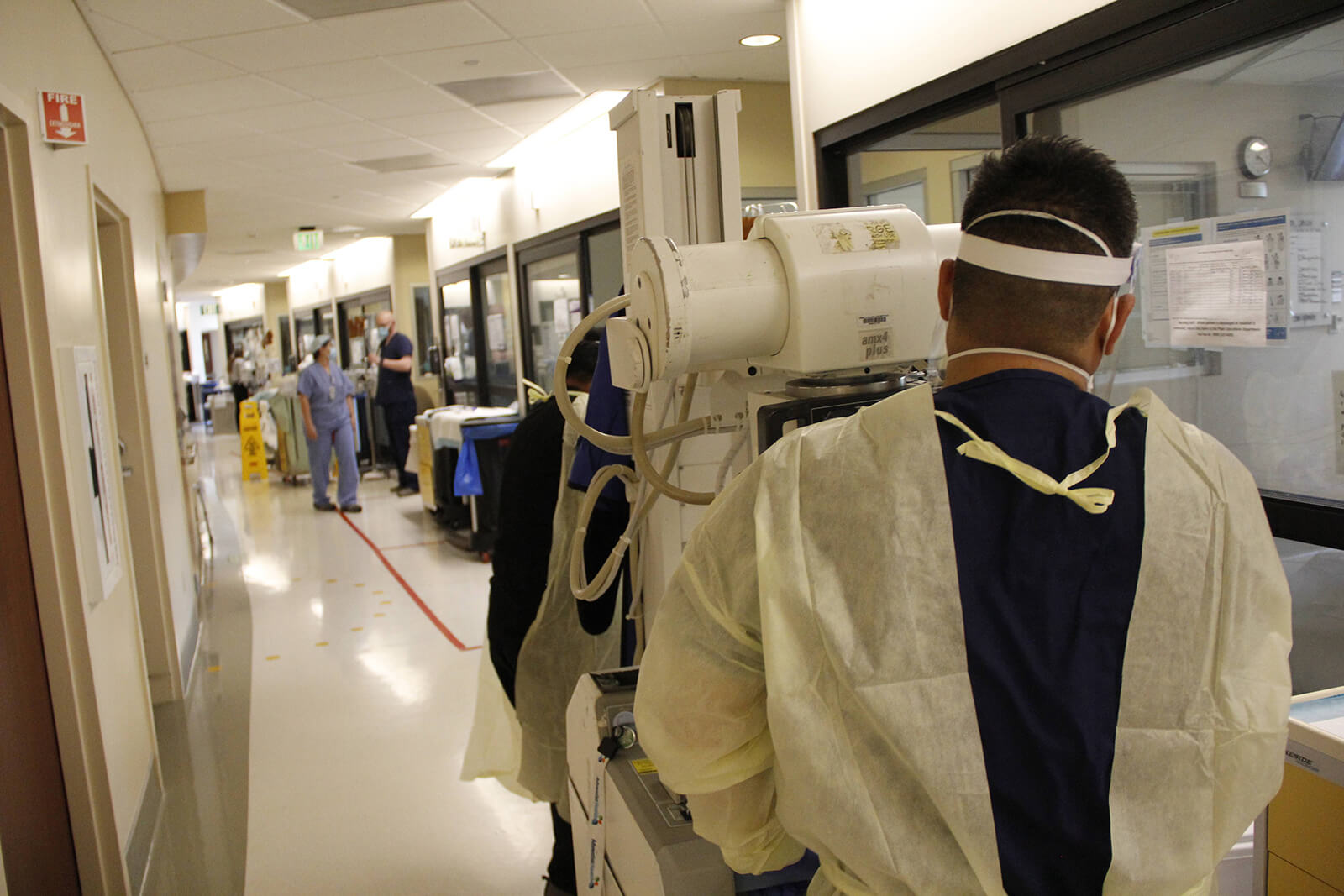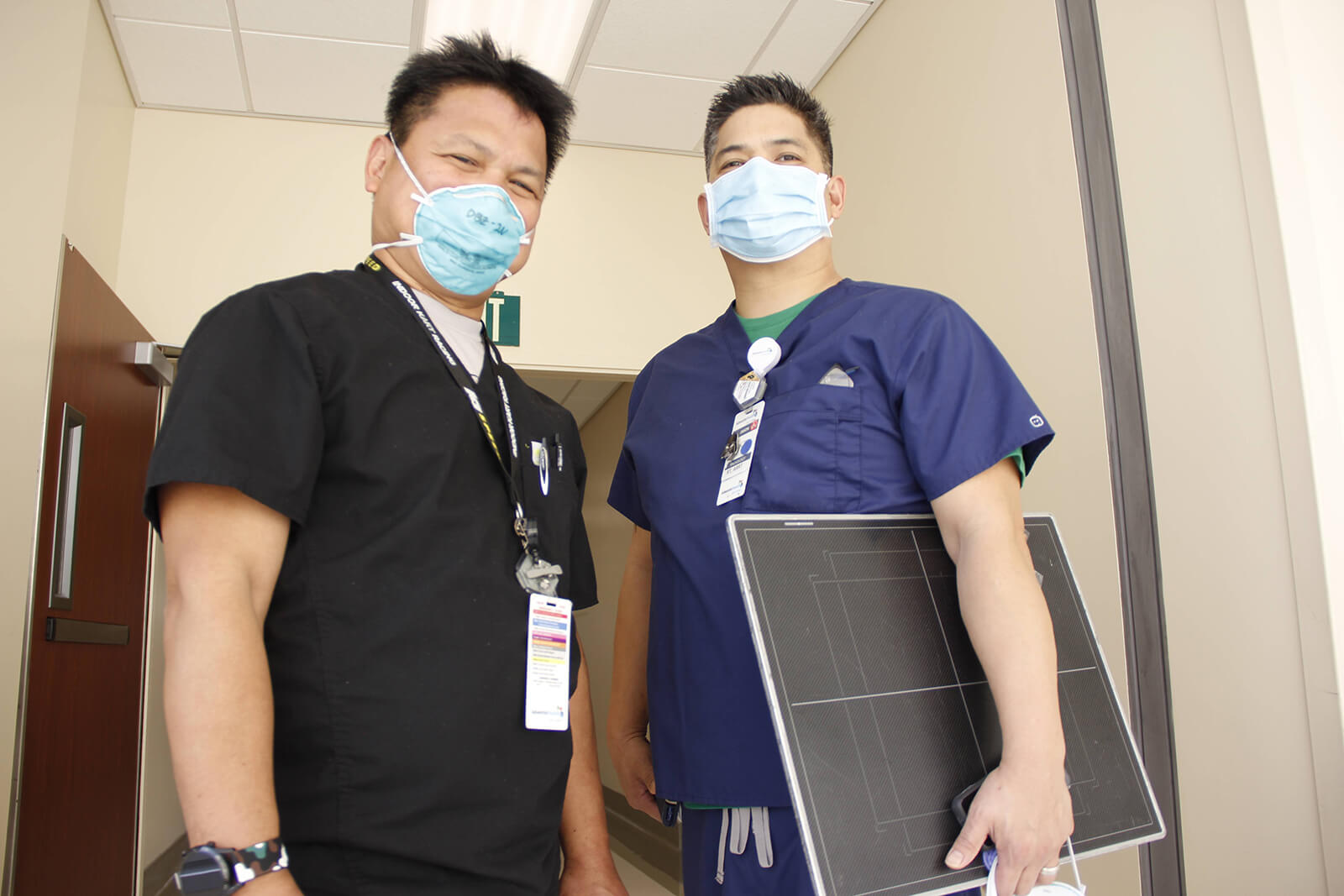
‘We’re battling Goliath’: Radiology family comes together during pandemic
When Manny Cabal looks at the chest X-rays he shoots each day, he can see COVID-19.
It’s that hazy patch of white on the scan of the middle-aged man on the second floor. It’s the white speckles Manny sees on the lung of the woman around the corner. Later, he’ll X-ray that woman’s father down the hallway and glimpse COVID-19 in his lungs, too.
“You see these X-rays, and you just shake your head,” Manny said. “You see how bad it is on the news at home, but it’s different when you witness it with your own eyes. My God.”
Manny is just one of the many radiology technologists who each day travel throughout the hospital with a portable X-ray machine taking scans of patients’ insides, cataloguing each day the severity of disease in images. Like most healthcare workers, RadTechs jobs have become ever more challenging since the pandemic began.

Each day, RadTechs shoot almost four times as many chest X-rays as they did pre-pandemic, and each one now takes longer and requires more staff because of the need to wear gowns, gloves, respirator masks and shields. Procedures that used to be straightforward now require cumbersome workarounds because of COVID-19. When a patient comes to the emergency department suspected of having COVID-19, RadTechs are called in as first responders to shoot the chest X-ray because it will deliver faster results than even the best rapid response COVID tests. They wonder when it will all slow down.
It used to be that RadTechs didn’t typically know the outcomes of patients they’ve photographed. They come into patient rooms, shoot images, then leave. Sometimes they’ll see them the next day on their rounds, and sometimes they won’t. Their outcomes were largely unknown.
Now, RadTechs like Manny can assume the outcomes based on the X-rays.
He remembers which patients’ chest X-rays look good and which look bad. He passes through the COVID-19 Intensive Care Unit where the most serious patients are treated. Just the day before, the corner room was occupied. Now it’s empty.
It’s a subtle reminder of the viciousness of the virus.
“Patients with chest X-rays like these aren’t going to be discharged,” Manny said. “If they’re not in the room anymore, it tells you they didn’t make it.”
It’s a hard reality that healthcare workers face daily.
As Manny makes his way through the Intensive Care Unit, he received a call from a doctor asking about placing a PICC line – an intravenous method of delivering medications to a patient by way of a catheter that’s inserted through a vein in the arm and them routed near the heart. It requires a RadTech’s expertise to ensure the line is placed properly.
These types of procedures typically take place in the radiology department where a technologist could inject contrast and use fluoroscopy to project live images of the catheter being placed. But with infectious COVID-19 patients, those PICC lines must be placed in the patient rooms – a caveat that makes the process more tedious. In those instances, it’s a back-and-forth where the doctor places the catheter, the tech shoots a chest X-ray, checks the line placement, and then adjusts. Sometimes it can take more than an hour.
Manny got off the phone and budgeted it into his schedule for the following day.
Radiology is a small department. If anyone calls out sick, the entire department feels it, Manny said. He’s grateful that doesn’t happen often.
“It’s dedication,” Manny said. “Our job has gotten so much more difficult with COVID, and the extra work we do, and the exposure we have and worrying whether our families will be OK – but look at our department. Nobody ever calls our sick.”
It’s a sense of duty that keeps them coming back, Manny said.
He’s seen it in his own family. His wife is also a RadTech. She quit her full-time job in January 2020 to spend more time with family.

When the pandemic struck, she went back to work as a traveler assisting hospitals in San Francisco that had been hard-hit by COVID-19. Every time her contract has ended, she has renewed, Manny said.
“She sees these ill people dying from COVID and she says: ‘how can you give up now when so many need you?’,” Manny said. “I feel the same way.”
When their son, Nathan, saw the dedication of his parents, it inspired him. He asked for a leave of absence from his job at Target and came to volunteer as a COPE scholar at Adventist Health Simi Valley.
“We’re battling Goliath,” Manny said. “Nobody beats Goliath unless they come together. That’s what we’re doing, and that’s what I find most gratifying.”


